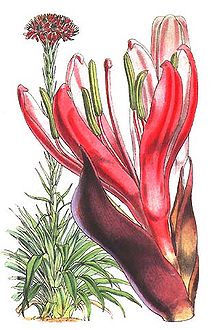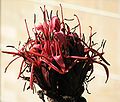- Doryanthes excelsa
-
Gymea Lily 
Scientific classification Kingdom: Plantae (unranked): Angiosperms (unranked): Monocots Order: Asparagales Family: Doryanthaceae Genus: Doryanthes Species: D. excelsa Binomial name Doryanthes excelsa
CorreaThe Gymea Lily (Doryanthes excelsa) is a flowering plant indigenous to the coastal areas of New South Wales near Sydney.
The plant has sword-like leaves more than a meter long. It flowers in spring and summer, sending up a flower spike up to 6 m high, which at its apex bears a large cluster of bright red flowers, each 10 cm across.
The name "Gymea Lily" is derived from a local Eora dialect. Dory-anthes means spear-flower in Greek, and excelsa is Latin for exceptional. The Sydney suburbs of Gymea and Gymea Bay are named after the lily.
Contents
History
The genus Doryanthes was first described in 1802 by the Portuguese priest, statesman, philosopher and botanist José Francisco Correia de Serra (1750–1823), a close friend of Sir Joseph Banks. Doryanthes excelsa has also inspired the naming of Doryanthes, the journal of history and heritage for Southern Sydney founded by Dharawal historian Les Bursill.
Aboriginal use
Honey-eaters love the nectar of these large, crimson flowers on stems 2–3 m tall. These birds were ready prey to be cooked and eaten!
Aboriginal people in the Lake Macquarie district of NSW were observed in 1836 roasting the stems, having cut them when half a meter high and as thick as a person's arm. They also roasted the roots which they made into a sort of cake to be eaten cold.
References
- Australian National Botanic Gardens:
- aboriginal use, retrieved 28 April 2006
- drawing, retrieved 28 April 2006
- a specimen in the ANBG, retrieved 11 October 2005.
Image gallery
-
Australian native growing in Heathcote National Park, Sydney.
]
Categories:- Doryanthaceae
- Flora of New South Wales
- Flora of Queensland
- Endemic flora of Australia
- Asparagales of Australia
- Garden plants of Australia
- Drought-tolerant plants
- Flowers
- Words and phrases of Australian Aboriginal origin
- Australian National Botanic Gardens:
Wikimedia Foundation. 2010.








